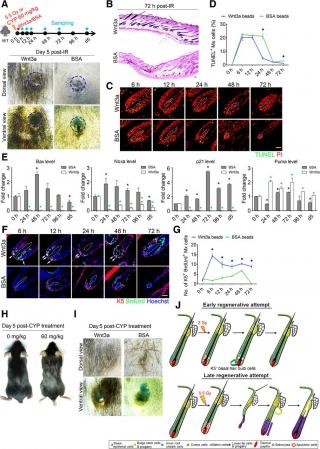Nov, 2017

Genotoxicity-induced hair loss from chemotherapy and radiotherapy is often encountered in cancer treatment, and there is a lack of effective treatment. In growing hair follicles (HF), quiescent stem cells (SC) are maintained in the bulge region, and hair bulbs at the base contain rapidly dividing, yet genotoxicity-sensitive transit-amplifying cells (TAC) that maintain hair growth. How genotoxicity-induced HF injury is repaired remains unclear. We report here that HFs mobilize ectopic progenitors from distinct TAC compartments for regeneration in adaptation to the severity of dystrophy induced by ionizing radiation (IR). Specifically, after low-dose IR, keratin 5+ basal hair bulb progenitors, rather than bulge SCs, were quickly activated to replenish matrix cells and regenerated all concentric layers of HFs, demonstrating their plasticity. After high-dose IR, when both matrix and hair bulb cells were depleted, the surviving outer root sheath cells rapidly acquired an SC-like state and fueled HF regeneration. Their progeny then homed back to SC niche and supported new cycles of HF growth. We also revealed that IR induced HF dystrophy and hair loss and suppressed WNT signaling in a p53- and dose-dependent manner. Augmenting WNT signaling attenuated the suppressive effect of p53 and enhanced ectopic progenitor proliferation after genotoxic injury, thereby preventing both IR- and cyclophosphamide-induced alopecia. Hence, targeted activation of TAC-derived progenitor cells, rather than quiescent bulge SCs, for anagen HF repair can be a potential approach to prevent hair loss from chemotherapy and radiotherapy.